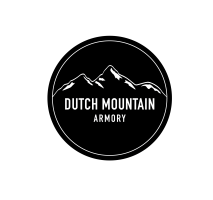Choosing a holster is much like choosing a pair of tennis shoes. Some shoes look great and say they are the right size, but they don’t fit. Big box stores have rows of holsters, but it is impossible to know if the holster on display will fit you and your handgun. A local gun shop will help you choose a holster that works with your handgun, fits you comfortably, and will not print while you wear it. Let’s look at a few ways to ensure you choose the right holster for your handgun.
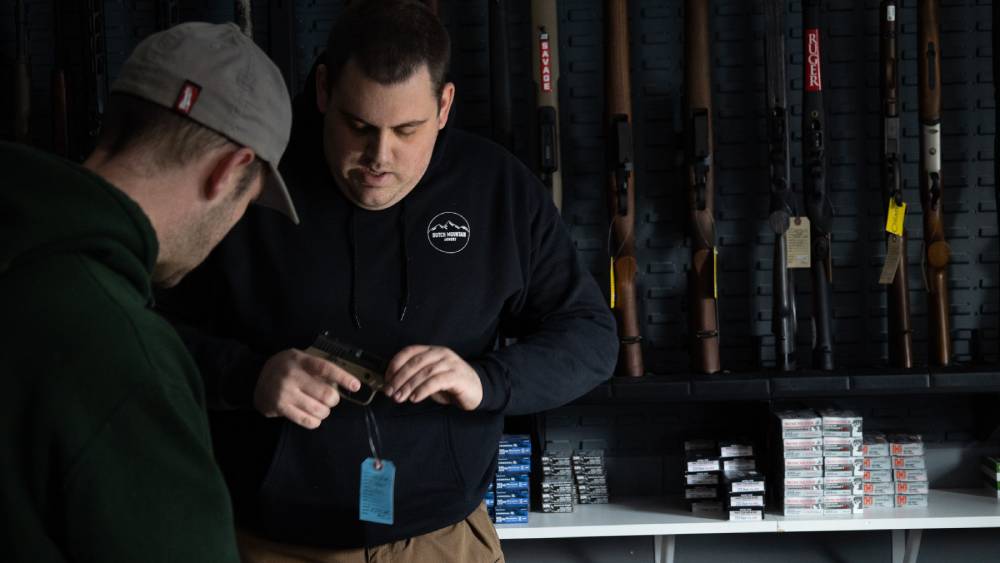
What to Know, Before You Choose
If you’re shopping at a big box store, finding someone to answer your questions is often difficult. Getting permission to open the package and try a holster on is next to impossible. You are better off with a local gun shop like Dutch Mountain Armory that will let you kick the tires on several holsters. They are there to answer your questions but will have a few questions for you too.
Questions you might hear:
- Is the holster for concealed carry, tactical shooting, or both?
- How active do you plan to be while carrying your handgun?
- What are you typically wearing when you carry?
- What is more important to you? How easy is it to draw your weapon, or how to secure it in the holster?
- How many handguns do you need a holster for, and do you carry each one for different reasons?
These are just a few questions a pro at your local gun shop will ask. The more of these questions you can answer, the better the fit your holster will have. It’s not an interrogation, but both you and the local gun shop should work together to find a holster you are happy with.
The Inside-the-Waistband Holster

The inside the waistband holster is just that, a holster that fits inside the waistband of your pants. It is a great choice if you want to conceal carry your handgun. With an inside-the-waistband holster that fits properly, you should not print while carrying. The term printing is used to describe a situation where the outline of the handgun is noticeable or printing when someone is concealed carrying. In some states, printing is illegal. It is up to the person conceal carrying to ensure no one around them can see the print of the handgun.
The inside the waistband holster is just that, a holster that fits inside the waistband of your pants. It is a great choice if you want to conceal carry your handgun. With an inside-the-waistband holster that fits properly, you should not print while carrying. The term printing is used to describe a situation where the outline of the handgun is noticeable or printing when someone is concealed carrying. In some states, printing is illegal. It is up to the person conceal carrying to ensure no one around them can see the print of the handgun.
Another advantage of the inside-the-waistband holster is that it is easier to carry in warm weather. All you need to conceal your handgun is a loose-fitting shirt, no need for a jacket or vest. A couple of drawbacks to the inside-the-waistband holster is that it can be uncomfortable, especially if the handgun touches your skin. When a handgun contacts the skin, it often causes you to sweat, and your handgun is exposed to moisture. Also, you will need a bigger pair of pants; the pants you wear today may not have room to slide a holster inside the waistband.
Note: Practice drawing and holstering your handgun with any holster. With the inside-the-waistband holster, you need to pull your shirt up with one hand and draw with the other.
The Outside-the-Waistband Holster
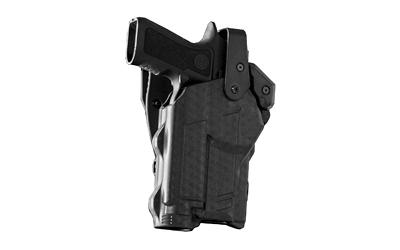
There are many types of outside the waistband holsters. The most popular are the holsters your belt slides through or clips onto your belt. Another popular choice is paddle-type holsters that clip over your belt and waistband. These are popular for those who need to easily remove their holster to enter a building where handguns are not permitted.
Outside-the-waistband holsters work well for those who carry large semi-automatic handguns or revolvers. These handguns are too large to carry comfortably with an inside-the-waistband handgun. The outside-the-waistband holster is easy to draw and holster, but special care must be taken if you plan to conceal carry with one. They print easily; a jacket or vest is often needed to conceal the handgun properly.
The Belly Band Holster
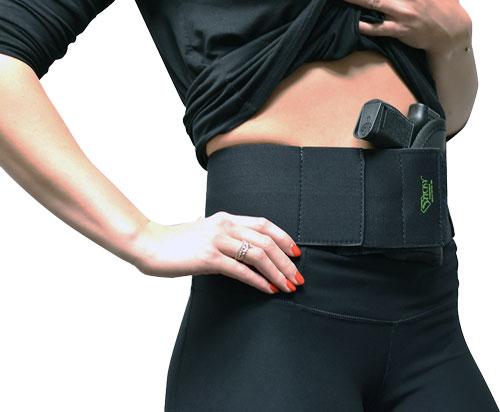
The belly band holster is a great choice to conceal carry. A belly band holster is for almost any handgun designed to conceal carry. Some models have pockets for pepper spray and additional magazines. There are belly band holsters that fit just above the waistline and others that fit as high as the chest. You may want to try several on before you decide which one is most comfortable. They are a great choice for those who need to wear a skirt or in situations where they are active and still need to carry.
The drawback to the belly band holster is it can be quite warm when carrying during the summer. Many will choose to use a different holster in the summer and a belly band when it’s cooler. Also, the belly band needs to be tight to keep it from sliding down, so some consider it too uncomfortable to use daily.
The Shoulder Holster
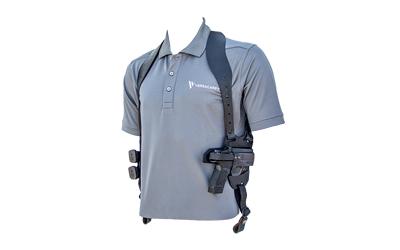
The shoulder holster is great for those who spend all day driving or sitting down. You don’t need to stand to draw your handgun with a shoulder holster. You can also draw your handgun from the holster easily and quickly. Some shoulder holsters will hold additional magazines or speed loaders. You can find models for both open and concealed carry. Of course, any shoulder holster you can conceal carry with, you can also open carry with.
The big drawback to the shoulder holster is that to conceal carry, you need a jacket. That’s something not everyone wants to do, especially down south. Another thing to consider is that when holstered, the muzzle of the handgun is pointing to the rear. That is not optimal when it comes to muzzle control, so they are not allowed on some gun ranges.
FAQ’s
- If you need to conceal carry, make sure the holster is adjustable. Holsters that allow you to adjust the height and angle of the handgun will help the holster fit the shape of your body.
- The one size fits all holsters are generally nylon and prone to stretch. When it comes to holsters, there is no such thing as one size fits all. Think twice before choosing a nylon holster.
- Leather holsters are nice, but they often collapse when you’re wearing them without a handgun. This means to holster your handgun, you need one hand to hold the holster open and the other to slide the handgun in.
- Holsters made of Kydex keep their shape and are easy to draw your handgun from. Many are adjustable, so you can customize how easy it is to draw while maintaining proper retention.
- Many Kydex holsters click when the handgun is seated correctly, so you always know when your handgun is holstered properly.
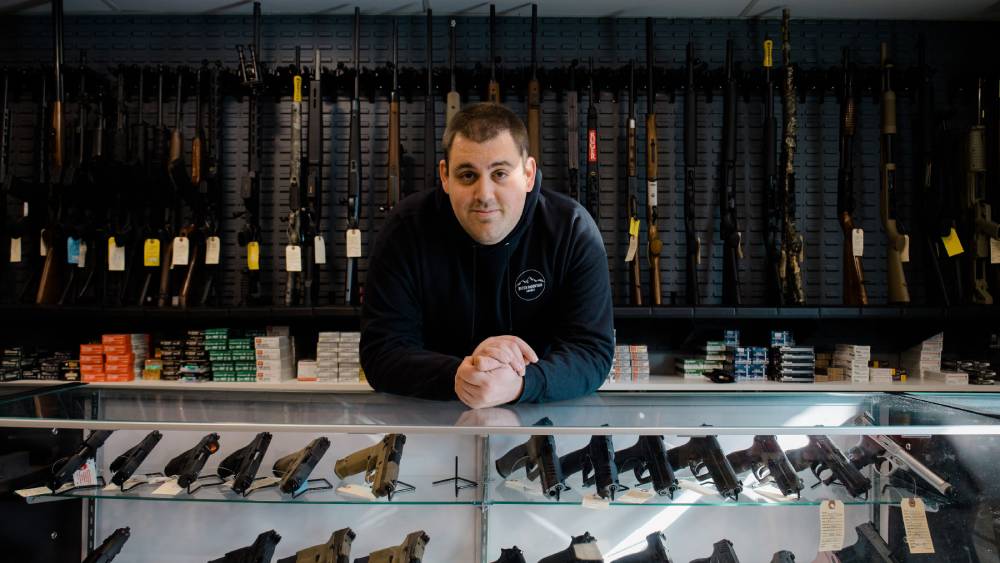
Choose Wisely
Much like choosing tennis shoes, you must try a few holsters to see what feels best. That’s why local gun shops like Dutch Mountain Armory are such a big help. The pros will take the time to ask the right questions to put you in the right holster. They can help you decide if a single holster will do or if you are safer with several holsters specific to each situation you carry in. The relationship you build with your local gun shop will help you choose the right holster and gear for all your handgun needs.
